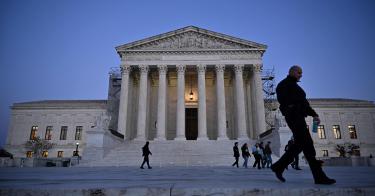Saying that public officials should be “ethical” is like saying that sunshine and puppies are good things. The tougher questions are what “ethical” means, how to tell if public officials meet that standard, and what to do if they don’t.
So, we should be wary of the current campaign to exert control over the Supreme Court by creating a fake “ethics crisis” and smearing justices whose decisions may not reliably advance specific political interests. On November 13, the court announced the adoption of its own code of conduct, a positive step unlikely to satisfy the critics.
This campaign knows its primary narrative, that the Supreme Court has no ethical rules, is false. The Ethics in Government Act governs financial disclosures and applies to all federal judges and Supreme Court justices. Another federal statute, which also applies to the justices, sets standards for when they should not participate in a particular case assigned to them. The Supreme Court has publicly committed to follow the Code of Conduct for U.S. Judges, which formally applies to lower court judges, and has done so for decades.
>>> Conservatives Can’t Sleep on the Fight for State Supreme Courts
The critics’ objective is not to seek a legitimate solution to a genuine problem but to foster the false notion that there must be something wrong at the Supreme Court and create the appearance that the court can be forced to knuckle under. The Supreme Court’s new code of conduct and how the court announced it undercut the critics’ strategy.
The code is virtually identical to the one that justices follow; each is organized into the same five ethical canons. The only substantive difference, if it can even be called that, is the Supreme Court code’s additional detail about recusal and activities such as speaking, teaching or writing. Putting the two codes side by side, however, shows this is a distinction without a difference. In other words, the court essentially put its name on the lower courts’ code that the justices were already following.
The Supreme Court issuing the code on its own was also important. Members of Congress have introduced legislation that would not only require the Supreme Court to take this step but with rules and standards far beyond what the lower courts’ code includes. The Constitution, however, does not give Congress this much control over the Supreme Court. Not only is the judicial branch separate from the legislative, but the Supreme Court was created by the Constitution, not by Congress.
Even liberal scholars such as Harvard’s Lawrence Tribe have said that requiring the Supreme Court to produce a code would be a “stark violation of the separation of powers.” By doing so on its own, the court respected the separation of powers and independence of the judiciary, even if Congress did not.
The critics, of course, are not satisfied, complaining that the Supreme Court’s code is not “binding.” Sen. Sheldon Whitehouse, D-Rhode Island, who introduced one of the mandatory code bills, issued a statement that there was no “mechanism to investigate possible violations and enforce the rules.”
>>> Originalism Keeps Judges in Check and the People in Charge
Just as the Supreme Court’s code mirrors that for lower court judges, it will be enforced the same way—within the judicial branch. The lower court code is enforced by the U.S. Court of Appeals in each judicial circuit and, candidly, there are few substantive steps that they can take.
However, the Constitution protects the judiciary’s institutional independence by providing that impeachment is the only way to remove a federal judge. The Constitution does not give Congress the power to poke around in what the judiciary is up to by investigating and trying to manipulate the Supreme Court’s decisions.
Ultimately, taking more direct ownership of the code of conduct that it already follows allows the Supreme Court to emphasize its responsibility to articulate and follow ethical principles and guidelines. By doing so on its own, in a way that maintains the essential division between the branches and exercising its own independence, the court took the right step in the right way.
The fact that the critics are complaining just shows that the integrity of the Supreme Court was never their goal in the first place.
This piece originally appeared in DC Journal




